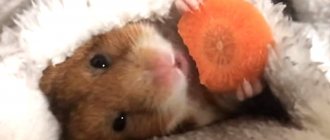- home
- General information
28.03.2018
The hamster is an animal of the steppe; in nature, it has practically no opportunity to fall from anywhere. Therefore, genetically, he is completely unadapted to falling:
- He orients himself in space using the sense of smell and touch (his blind eyes are not able to see the cliff).
- The hamster lacks a tail, which helps tailed animals turn over in flight and reduce the speed of their fall.
- His limbs are too weak to bear the weight of his body during landing.
Rodents are not at all afraid of heights, because they do not know about its dangers. This function is taken on by the pet breeder.
Vintage basket
Here we are dealing with a representative design in the style of modern rural fashion. Best suited for lovers of cycling or short distance travel on scooters. The basket itself is woven from flexible willow and equipped with an openwork wire lid, which prevents the cat from wanting to get out while moving. At the first glance at such a carrier, one is reminded of idyllic pictures from centuries ago, when food from the market was transported in a similar way on bicycles. The entire structure is conveniently attached to the steering wheel using leather straps and does not require much time for preparation.
The advantage of the option under consideration is, of course, its original design and originality. The downside is limited functionality. Although, if desired, the basket can be used for its intended purpose.
Price – 1,128 – 1,708 rubles.
Useful video
Often you may not notice your pet's injury immediately, but after several days, when the hamster's paw changes color and the hamster limps.
But it is important to provide the right help as soon as you notice the animal’s suspicious behavior.
Hamsters are small, very active animals that love to run and play. Unfortunately, the active lifestyle of a furry pet often leads to injuries. Additionally, if you have multiple hamsters that don't get along very well, they may fight and cause some pretty serious injuries to each other. If you notice that your pet has been injured, you need to act quickly: provide the pet with the necessary assistance and help it quickly return to a normal, active life.
Rehabilitation after a fracture
Complete recovery of a paw after a fracture can take 2 to 4 weeks. During this period, mobility restrictions are still relevant. If for some reason the animal needs to be returned to the cage, all ladders, running wheels and other toys should be removed from it. Change the litter regularly.
After consulting a doctor and providing first aid, the pet should be closely monitored. After the first three days, you can judge the success of the therapy. If the paw begins to dry out or turn black, you need to urgently consult a doctor - amputation is required. However, sometimes animals simply gnaw off an injured limb; this instinct is inherent in them by nature.
Caring for an injured hamster
With a closed fracture, owners rarely take their hamster to the clinic. In their own way, they are right: regardless of the type of injury, if there is no damage to the skin, wounds, the same care will be prescribed
Limited mobility
In the absence of a carrier, use an ordinary plastic bucket, basin or deep container.
If it is not possible to transfer the victim from the lattice cage, then all toys (wheels, tunnels), ladders, and the second floor are removed.
Dosed feeding
If the front leg is injured, the hamster should not be allowed to stuff its cheek pouches. It will be difficult for the rodent to get food from there on its own, and inflammation will occur. A grain mixture in a small bowl will help keep the cage clean. A complete and balanced diet for the hamster must be provided. Peace is all a pet needs.
A closed fracture of a hamster's paw does not cause death, although lameness often remains if the bones do not heal properly. The situation is different if the injury is more serious - an open fracture.
Reasons for the fall
Often associated with careless behavior of the breeder, or with his limited knowledge in the field of rodent breeding. It could be:
- Wrong choice of housing. You should not buy a cage with two floors for your hamster, as some can reach 50 cm in height. Choose a cage with bars located close to each other. Thus, the animal will not have the opportunity to get out of its home and injure itself in any way.
- Wrong walking. Don't let your pet go on an independent journey, because there are no limits to his curiosity. A fall, even from a small height, can have serious consequences. Buy him a walking ball that will protect the rodent from all dangers.
- Disdainful attitude. Don't let children treat the hamster like a toy. Take it to playgrounds, twirl it in your hands, and constantly move it around the house.
- Dangerous cage accessories. High labyrinths and stairs can cause your pet to fall.
- Untamed hamsters can behave aggressively. Do not pick up an animal if it is not used to you. A frightened animal may try to escape by jumping to the floor.
Remember that hamsters are animals of the steppe or desert; they do not know how to group and fall correctly. If a hamster fell, then, at best, he received a shock, at worst, he broke his spine, because when a rodent falls, it can receive injuries of varying degrees of severity.
Symptoms
A paw fracture is an injury to the bones of the fore or hind limb. Depending on the injury received, the following types of fracture are distinguished:
- Open. Characterized by damage to the skin and protrusion of the bone.
- Closed. With such a fracture, the integrity of the skin is not damaged, but the bone is partially or completely broken.
Symptoms of a fracture:
- Strong pain. When you feel the sore paw, the animal may behave aggressively, try to get out of your hands or bite. In this way he reacts to the pain in a broken limb.
- Bend the paw. In order not to touch the sore paw, the rodent bends it under itself.
- Unnatural mobility. A tarsus fracture may be characterized by a dangling limb.
- With an open fracture, the bone is visible.
- Swelling or hematoma may form near the site of injury.
- The hamster may refuse to eat.
A bending does not always mean that the hamster has broken its leg. Perhaps it's just a dislocation. The condition is painful, but less dangerous than a fracture. How to distinguish a dislocation from a fracture? When a limb is dislocated, the animal may partially rely on the injured paw and limp. The same symptoms accompany a bruised paw.
How do hamsters die?
The death of a pet can be expected or sudden. Hamsters can die screaming or absolutely silently. Here are the signs that your hamster is dying suddenly:
- if the pet is sick, he will cry, gradually his voice will turn into a fading wheeze;
- if a pet falls from a great height, it can damage its spine, in which case its body will be limp, and death will occur within an hour;
- The paralysis of an animal can be determined by its immobility. Khoma breathes, can eat a little, but is no longer able to move independently. From now on, the hamster's days are numbered.
In the case of prolonged illnesses and old age, the following external signs will help to recognize the approaching death of the animal:
- The animal became lethargic and unsociable, although previously it was willing to be handled.
- Sudden weight loss and the animal's refusal to eat indicate that the end is near. Also, a sure sign of dying is that the homa has stopped storing food: he feels that he will not need food soon.
- The animal's eyes do not shine as before and gradually become cloudy.
- The fur takes on a dull appearance and begins to fall out or become matted.
When does a hamster fall on its back?
A fall should be understood as a sharp or slow rolling from the paws to the back. In this case, the animal may squeak or, conversely, make louder sounds. The accompanying symptoms will tell you what the main reason for this behavior is.
Fight with another hamster
It is known that these rodents love solitude and do not accept proximity to other animals, even of the opposite sex. The mating period between males and females lasts no more than an hour, after which two adults can fight even to the death. In this fight, the male often dies, since the female is by nature more aggressive and always considers herself the mistress of the cage.
Sorry, there are no surveys available at this time.
Many rodent owners are interested in the question of why hamsters fight and whether it is possible to make two males or two females coexist peacefully in the same cage. The answer is simple: no matter how many animals you have, each of them should have its own home, and nothing else. If you do put your pets in the same cage and notice that your hamsters are fighting, then move them out as soon as possible.
Disease
Another reason why a fluffy puppy falls on its back and rolls over may be the pet’s painful condition. If at the same time he squeaks, screams, or, conversely, looks lethargic and inactive, then you should quickly take your pet to the veterinarian to find out the reasons for this behavior. In the meantime, first examine the rodent: sometimes the symptoms of the disease are visible to the naked eye.
Swimming on land
Another reason why a pet can roll over on its back is a banal instinct. The fact is that in the wild, rodents bathe in sand in order to somehow fight parasites. These instincts are retained during their life in a cage. You don’t need to do anything about it, just monitor your pet’s behavior and health.
Causes of falls and sources of danger
There are many factors that contribute to pet falls.
It is important to find out the cause of what happened in order to prevent this from happening in the future. From a breeder who ignores the reason? pet injuries are quite common
A small rodent may fall from a height if:
- the cage is incorrectly selected for the size of the animal, there are many dangers in it (ladders, swings, high labyrinths);
- the bars of the cage are too wide, or the door is not closed, and the pet has the opportunity to escape from it;
- the hamster moves freely around the house without supervision;
- the pet often “travels” around the apartment in a person’s arms.
Sources of increased danger for hamsters include:
High cage. The height of the cage itself and the place on which it stands are also important. If possible, place the cage closer to the floor: on a low bedside table, stool, or directly on the floor
It is very important that other animals and small children cannot harm the pet. Furniture in the house
Don't let your hamster wander around the table, even if you keep an eye on him! Small rodents are very nimble; in an instant the animal will be on the edge and fall down from the table. Let him run around on a fenced area of the floor without the opportunity to climb onto the sofa or crawl into a narrow gap. It is better to have a special ball for walking around the apartment, so the pet will always be in sight and avoid injury. Fall due to human fault. The domestic hamster is a pet for observation rather than play. Explain to your child that a hamster cannot be squeezed like a cat, it is very fragile. To prevent your pet from falling out of your hands onto the floor, carry it from place to place only in a carrier or container. Do not pick up an untamed animal; it is very timid and may start to break free and bite. Let the hamster get used to you, invite him to climb into your palm. At first, do not take him out of the cage, stroke the pet with your thumb, scratch his belly. When the hamster begins to trust you, you can take him out for a while. Do not carry your hamster on your shoulder or in your pocket. The animal does not understand that it can fall.
Given these simple rules, it is easy to ensure the safety of your pet and prevent injury.
https://youtube.com/watch?v=CqK4SU5TcR4
How to prevent escape?
To prevent your pet from escaping again in the future, take a number of simple measures. First of all, check the strength of the hamster’s home: whether the door is securely locked, whether the rods are loose. Always close the cage, even if you are only distracted for a couple of minutes.
Make sure that the animal is comfortable, there are no irritants, and there are enough toys. Make sure the cage is located in a quiet, calm place, away from direct sunlight or drafts.
Clean your hamster's house regularly. While cleaning, place your pet in a deep container or walking ball.
And most importantly, pay more attention to the hamster: play, pick it up more often. Please note that this must be done when the pet is awake, otherwise you will achieve the opposite effect.
Consequences of a fall and first aid
Due to the structural features and fragile skeleton, the consequences of a fall can be very serious. If your hamster falls from a height, assess its condition in order to begin first aid.
- After the fall, the hamster quickly hid and did not enter. The animal was very scared. It is not yet possible to determine the presence of damage.
Do not pull it out by force, let the animal calm down. Trying to reach it with various objects or moving furniture will frighten the animal even more. After a few minutes the pet will run out on its own.
- The hamster fell on its back and did not move. Don’t immediately panic and think that your pet is dead. He could have gone into shock from the sudden fall. It is impossible to determine external or internal injuries in this state of the animal (however, if there is an open fracture, you will notice a protruding bone and a bloody wound).
Carefully transfer your pet to the cage (or better yet, to an open container or basin). When the hamster comes to, assess its physical condition and mobility.
- A few hours after the fall, when the pet recovers from shock and fright, the severity of the consequences can be assessed. If the hamster clenches its paw, limps, and the paw itself darkens and swells, it means there is a fracture. If the hamster drags its hind end, a spinal injury has occurred. Blood and foam from the mouth indicate damaged internal organs. If a bruise is visible on the abdomen or it is unnaturally swollen, the internal organs are damaged.
If you notice such signs in an animal, first of all, keep it still and transfer it to a small basin or container filled with white paper. Try to see a veterinarian as soon as possible. If a hamster's internal organs are damaged, it cannot be saved. A hamster that has suffered fractures (even if the spine is broken) can survive, despite its disability, and will be cheerful and active. The main thing is to provide timely assistance and proper care.
- If the hamster is outwardly active and cheerful, but eats little, most likely the teeth were damaged due to a fall. This is not a big deal, as new teeth will grow within a week.
During the period of teeth regrowth, switch your pet to soft food, in a few days he will be as good as new. If only one tooth is broken, the second one will have to be filed or trimmed until the hamster begins to grind down the teeth itself.
If there is no damage to internal organs or severe fractures, rehabilitation after falls proceeds quickly. Care consists of restricting movement, hygiene of the place of detention, taking medications (if prescribed by a doctor) and a special diet.
Don’t forget the main rule: prevention is easier than cure.
Treat small animals with extreme caution
https://vetklinik-msk.ru/simptomy-gryzunov/simptomy-khomyakov/922-khomyak-upal-s-vysoty https://www.krasnouhie.ru/chto-delat-esli-xomyak-upal-s-vysoty. htmlhttps://homjakam.ru/bolezni/homyak-upal-s-vysoty
Consequences of "flights"
What happens if a hamster falls from a height? Falling from any height is a fairly common occurrence for domestic hamsters. Most rodents with long tails are endowed with the ability to turn over “in flight” and land on their paws, but hamsters, unlike long-tailed rodents, do not roll over this way.
Therefore, even falling from the height of a desk or kitchen table onto a soft surface (linoleum or carpet), the animal can receive serious injuries.
After falling from any height, even if the animal has not received any serious injuries, pet hamsters act like monkeys, that is, they imitate their death - they lie on their backs and barely breathe . This behavior of a domestic rodent indicates that the animal has experienced a severe shock and needs time to recover. I would like to note that hamsters are very nimble, but rather clumsy animals. Leaving them unattended, even for a moment, you may notice with annoyance that your hamster has fallen from a great height and is lying on the floor with its paws up.
Having found your “pilot” in this state, carefully transfer him to the cage, place it closer to the warmth and create twilight for the fluffy. Your next steps are to monitor the baby, check how the hamster feels every hour, but do not disturb him.
If the rodent can soon get up and begin to actively run around the cage, eats well, and willingly leaves its house - everything is fine with the animal. To relieve stress in an animal, support its body by simply giving special vitamins for rodents.
A hamster broke its leg - what to do, how to understand and provide assistance in case of injury
Suspicion of a broken limb in a tiny animal often causes panic among owners.
After all, it is completely unclear how to help the animal, what to do with a tiny paw and how to limit the mobility of an unreasonable pet.
If you consider that hamsters are very often kept for children, then you won’t envy adults at all. However, not everything is so scary and in most cases the owners are quite capable of helping their pet.
A hamster can have a closed fracture as well as an open one.
How can you tell if your paw is broken?
Even animals that do not leave their cage often suffer bruises, sprains and dislocations. Often these types of injuries go unnoticed because the animal in pain reduces physical activity and hides in its house until the discomfort passes. The fracture can be open or closed:
Closed fracture
- the limb hangs unnaturally;
- the animal moves on three limbs, pressing the injured paw to the body;
- the injured paw is swollen and there is noticeable bleeding;
- the hamster tries to move as little as possible and refuses food.
IMPORTANT: You should not palpate a rodent's paw to diagnose a fracture, since the hamster's bones are too thin for a fracture to be detected by palpation. This will aggravate the injury and cause unnecessary suffering to the animal. If possible, it is recommended to take an X-ray to make a final diagnosis.
A closed fracture is often confused with a dislocation. A modern digital device is able to detect fractures in even the smallest animals
If possible, it is recommended to take an X-ray to make a final diagnosis. A closed fracture is often confused with a dislocation. A modern digital device is capable of detecting fractures in even the smallest animals.
Limited mobility
First of all, even before consulting a veterinarian, you need to limit your pet’s mobility as much as possible. To do this, place it in a bowl or container where a drinking bowl and feeder will fit, but there will be little room for movement. Place plain paper on the bottom - hamsters don’t like to stir it up.
Have you already taken your hamster to the vet?
How to feed a hamster with a fracture?
The most important rule for feeding an injured animal is moderation and lack of experimentation with food. It is better to reduce the amount of food a little
It is especially important not to allow your hamster to stuff food into its cheeks if its front leg is broken, as the animal may damage it further in the process.
It is best to give a grain mixture in a small bowl, green leaves and vegetables. Insect larvae, cottage cheese and kefir can be given in microscopic doses, provided that they were included in the hamster’s diet before.
There is a chance of getting purulent inflammation
Keeping the cage clean
Cleaning a cage with a sick animal should be done very often, at least once, and preferably twice a day. Completely replace the bedding (use plain paper instead of sawdust), change the water in the drinking bowl, immediately after feeding, remove the remaining food from the feeder so that the hamster does not stock up.
A sick animal needs to change its diet
Veterinary assistance
It is best to show the animal to a specialized specialist immediately after discovering a fracture. It is best to visit a doctor who specializes in rodents - a ratologist.
The veterinarian may prescribe pain medication for 1-3 days. If you managed to get to the doctor a few days after the injury and the wound has already festered, you may need injections of an antibiotic: Baytril, Enroxil or regular human bicillin-3 diluted with water for injection.
If a doctor recommends amputation of a limb, the owner had better agree. It will be performed under general anesthesia, and the stump will heal quite quickly. The animal’s quality of life will not suffer too much; they are quite well adapted to move on three or even two legs.
Limb injuries heal quickly
Conclusion
A broken limb of a beloved animal is often a shock to the owner, but quality care and timely treatment will help the hamster recover quickly and live a long, fulfilling life.
Diagnostics
You should not try to palpate the fracture. Even a specialist in a veterinary clinic should not do this: the bones of rodents are too thin to assess their condition with your fingers. It makes no sense to cause additional suffering to the animal.
Modern digital x-rays make it possible to see a fracture in even the tiniest animals. If the injury is obvious, the owner often doubts the need to take an x-ray - after all, it is already clear that the hamster has broken its leg. Images are needed to distinguish a fracture from a dislocation, as well as to get a complete picture of the injury. Without this, it is difficult to give a prognosis and prescribe treatment.
The hamster fell from a height, what should I do?
Small rodents should be monitored especially carefully. It happens that the hamster fell off the table
or from a chair.
They do not feel at all and are not afraid of heights. This happens quite often, so every owner should know what to do if the hamster falls.
Hamsters can fall not only from furniture, but also from your hands. These animals are quite harmful and capricious, so they can break out. If the hamster fell from a height
human growth, then injury is guaranteed. You need to hold the baby tightly in your hands and immediately let go if he starts to struggle. This will prevent your pet from falling.
First of all, if the hamster fell
and began to run away to a secluded place, then there is no need to immediately catch him. This is extremely stressful for a rodent. He needs to be given time to come to his senses. At worst, he may go into shock. In this state, the hamster lies motionless on its back for several minutes.
How to help a hamster after a fall?!
So, the hamster fell from a height, what should you do?
First of all, it needs to be placed back in the cage. He will rummage around in the cage, looking for a secluded place. All this is the result of stress. Give him some time to recover from the shock.
If the Djungarian hamster fell,
this can lead to broken limbs, damage to internal organs, and fractures of incisors. Even if the hamster continues to run after the fall, it can be a shock. In such situations, the rodent can move with broken limbs.
A closed fracture can be detected the day after the fall. At the same time, the rodent moves unnaturally and limps on its leg. With an open fracture, the wound is visible and the limb is turned to the side. If the spine is damaged during a fall and internal organs are damaged, the baby will be doomed to death.
If the hamster fell from a great height
and only damaged the spine, then with proper care he will be able to live on. But at the same time, the hind limbs remain paralyzed for life. This will not prevent the rodent from leading an active life.
The ratologist will examine the pet and draw conclusions. You can call a veterinarian for your hamster at home. This will prevent further injury to the animal. At the same time, you will receive not only high-quality medical care, but also useful advice from a specialist.
Monitor your pet closely and try to avoid injury or illness.
Source
Can hamsters die from falling?
Unfortunately, hamsters can die from falling. What happens if your hamster falls may depend on the distance from which he fell and how quickly you help him. Hamsters are quite resilient due to the way their body has evolved, which gives them some advantages, but falling can still be dangerous. The risk of falling depends on certain factors.
Read also: Time difference with Thailand
© shutterstock
- Drop distance . Obviously, the distance of the fall is important. Hamsters can survive some pretty big falls; if your hamster jumps out of your hand, there's a good chance they'll come out unharmed. However, jumping from a cage, depending on the height of the cage, can be a more serious problem.
- Where does the hamster land ? By this we mean which part of the body the hamster lands on. Hamsters will always try to land on their feet, but if they fail this can become a serious problem. A hamster's back is quite fragile, and landing on its back can damage it. It's the same with their head.
- What does a hamster land on ? Typically the hamster will jump out of your hand and land on the carpet or hardwood floor. However, if your hamster lands on a sharp object, he may suffer cuts and wounds that can seriously harm him.
How to catch an escaped hamster
So, you have determined which room the escaped hamster is in, now you have an equally important task to catch the hamster.
The first step is to place the cage on the floor with the door open. You need to pour aromatic food into the feeder. Now all that remains is to wait for the hamster to smell the food and run into the cage. If you use an aquarium instead of a cage, then you need to empty it, put it on its side and install a feeder with food in it. Instead of a cage, you can use a wide-necked jar or bottle. As soon as the hamster runs inside, you need to take the jar and cover the exit, and then move the hamster into the cage. You can catch your hamster with his favorite toys - a running wheel or a ball. Leave them on the floor and wait until the hamster sees objects that are familiar to him. He will run inside, and you will carefully move him into the cage. If you see a hamster, you need to throw a towel over it, quickly and carefully pick it up in the towel in your hands and place it in the cage. A hamster covered with a towel will stop and freeze for a short time, and then try to escape
It is important not to miss the moment and grab the runner.
Important! If you find a hamster, and he stands still and does not run away, or is lying down, carefully pick him up (if possible) or move him onto a board and then into a carrier. You should take him to the vet immediately
The hamster could be injured when falling from a height, or get poisoned.
How to prevent escape
Catching a hamster does not always end successfully. To avoid having to search for and catch a hamster in the future, you need to prevent escape attempts.
Periodically check the cage for loose parts, walls, and the presence of cracks. Hamsters are rodents, so they are always gnawing on something. Therefore, hamsters should not be kept in cardboard boxes or cages with plastic rods. If the hamster is often interested in the door, chews on it and tries to open it, you definitely need to hang a lock or an additional latch
It is important that the door reinforcement should be iron and not plastic. Always check that the door is closed before leaving. Often, out of habit, owners forget to close the door and the hamster runs away
Habits develop over time.
Reasons why a hamster might escape
- First of all, it's curiosity. Leaving the door open will arouse interest and the hamster will run to explore new territories.
- Poor location of the cell. Perhaps you chose a place that is too noisy, for example, near the TV. Or they put a cage in the children's room.
- The hamster can also be frightened by other animals. It is worth choosing a place for the cage where other animals cannot reach.
- Boredom. Hamsters are very active and mobile animals. They definitely need to buy toys, a running wheel, a ball, a maze. Out of boredom, the hamster will begin to chew on the cage.
If your hamster runs away, the main thing is not to despair and continue searching. Hamsters are nocturnal animals; the easiest way to spot them and catch them is at night. The search for a hamster can take from several hours to several days. The main thing is to believe, and you will definitely find what you lost!
Taming
The taming process must begin at the time of purchase of the animal. Moving to a new place is a huge stress. Try to make transportation as comfortable as possible.
For this:
- do not catch the animal with your hands, lure it with treats,
- place it in a box or special carrier,
- put some old sawdust and usual food there in advance,
- go home immediately.
Upon arrival, place the box with the animal in the cage. Make sure he has enough water and food for the next 24 hours. After that, leave him alone. The main taming process will begin the next day.
First days in a new house
First, let him wake up. Don't disturb him when he's sleeping. This will be perceived as a sign of aggression.
Place the cage on the floor in a quiet room. Fence off the surrounding area so that the animal cannot escape. Remove the lid from the cage (only the tray should remain). There is no point in opening the door; the rodent will not come into your arms.
Talk to your hamster in a quiet and gentle voice so that he gets used to your presence. Give him something tasty, such as a piece of carrot or apple. Hold the treat in your hand and wait for him to start eating. Try patting him on the back
Do this carefully and avoid sudden movements. It may take several days for him to stop being afraid.
- Stroke the hamster's back from the shoulders to the hind legs. Try not to touch his head.
- Don't point your fingers forward. The animal may mistake them for food and bite you.
How to hold a hamster in your arms
The next step is to try to pick up the rodent. When he is no longer afraid of you, place a tasty seed in your palm. Most likely, he will come to your arms himself
Now it's important not to scare him
- Cup your palms and hold the hamster with its muzzle facing you. Raise it slightly off the floor. You should not raise him more than 20 cm. If he falls from a higher level, he may get hurt.
- Cover it lightly with your palm and stroke the back.
- Let him run from palm to palm, rearranging them.
- If he starts running too fast, block his path with your palm.
- If he doesn't try to escape, sit him on your lap. He might want to climb on your shoulder.
Hold your pet firmly, but do not squeeze, otherwise he may bite.
Features of taming the Syrian hamster
Typically, Syrian hamsters are tamed fairly quickly, as this breed is naturally friendly and curious. To speed up the process, use treats and toys. Try to make communication interesting for the rodent.
The Syrian hamster is larger than other representatives of the species, so the process of taming it can be safely entrusted to a child
It is important not to allow excessive attention to the hamster in the first days of his stay at home
At this time, close attention from the child will be perceived negatively
How to tame a dzhungarika to your hands
Dzungarik is wilder and less amenable to taming. It may take several weeks for him to get used to his owner. Do not try to pick up your baby before he has adjusted to the new place. If you bought a hamster for a small child, make sure that he does not squeeze the animal, as they are very easy to injure.
If you want to hold the animal often, buy one hamster. It is known that animals living in pairs do not make good contact with humans.
Rehabilitation after a fracture
Complete recovery of a paw after a fracture can take 2 to 4 weeks. During this period, mobility restrictions are still relevant. If for some reason the animal needs to be returned to the cage, all ladders, running wheels and other toys should be removed from it. Change the litter regularly.
After consulting a doctor and providing first aid, the pet should be closely monitored. After the first three days, you can judge the success of the therapy. If the paw begins to dry out or turn black, you need to urgently consult a doctor - amputation is required. However, sometimes animals simply gnaw off an injured limb; this instinct is inherent in them by nature.
Actions when bitten
Depending on the breed, hamsters may behave differently with new owners. For example, a decorative hamster can bite until it bleeds. But they are not predisposed to contracting the virus. The Dzungarian species shows aggression if it is not yet accustomed to people. The Syrian bites rarely, but bites the most painfully due to its size and greater strength.
If you are bitten by a domestic animal, you do not need to immediately run for a vaccine. If a rodent dies suddenly, an examination must be carried out to find out the cause of death.
Remembering that you were recently bitten by a hamster, it is not too late to vaccinate. It is carried out within 14 days after the bite. But you don’t just need to take the course, since it is unsafe and requires strict compliance with the instructions.
If, having started the vaccination course, more than 10 days after the bite the hamster is alive and has no symptoms, you can stop treatment. Rabies may not appear for a long time, and the virus can be detected in saliva approximately ten days before the first symptoms appear. But in herbivorous hamsters it cannot be detected in the saliva, since the virus only affects nerve cells.
Sources of danger
Falling from furniture
It's worse if the floor is tiled. But a relatively soft surface (linoleum, carpet) will not protect your pet from injury: hamsters do not know how to roll over and group in flight. Fortunately, if a hamster falls from furniture, it can get away with a slight fright.
Fall from hand
If a hamster falls from a height of human height, damage cannot be avoided. The animals have an independent character and can escape from the hands of a loving owner, slipping out and falling to the floor. It happens that suddenly the hamster bites painfully, and the person involuntarily throws the tiny rodent away.
In a cage
Even in his own house, a pet can climb up the bars of a lattice cage and fall down. Therefore, multi-tiered housing for hamsters is not recommended.
The hamster lies motionless: reasons
Everyone knows about the short lifespan of hamsters. And then a terrible thing happened: it seems that the pet died. Due to excitement, it is difficult to figure out what to do if the hamster lies and does not move, but is breathing. After all, the presence of breathing means that the animal is still alive. Before you run to the veterinarian, you need to try to figure out why your pet is lying motionless. Pay attention to other signs: whether the eyes are closed, how often the rodent breathes. If the eyelids are closed and breathing is calm, the hamster may simply be fast asleep.
What to do first
If your child falls out of bed, it is important to remain calm. As long as the child’s fontanels are not closed (large in the middle of the crown and small at the back of the head), in case of an impact they will protect the baby from fractures of the cranial bones
When a baby or toddler falls out of bed, it is important to remain calm and quickly assess the situation. Call 911 immediately without touching the child if:
Call 911 immediately without touching the child if:
- He lost consciousness
- The child is motionless (before the fall he was active, perhaps crawling and rolling over, after the fall he lies motionless).
- Convulsions appeared (the child’s arms and legs involuntarily twitch, eyelids tremble).
- Coordination is lost. This symptom can be observed in a child who already knows how to sit and perform actions with toys. For example, before the fall, he skillfully put objects into some container, but after the fall he cannot stand or stumbles every 2-3 steps.
- Vomit
- Sudden severe lethargy and drowsiness of the child.
- Strong crying
- Bleeding from the nose (this can be a rather dangerous condition, which indicates a serious injury to the cranial bones. Bloody or, conversely, clear discharge may appear from the ears).
Moving a child with a head or spinal injury can cause serious complications
However, if the child is in an area where there is a risk of further injury, he or she can be carefully moved to a safer location
If your baby is vomiting or having a seizure, gently turn him onto his side. Make sure baby's neck is straight while you turn over
Check him over carefully, paying close attention to his head and any bumps, bruises or other injuries. Check the rest of the baby's body, including the arms, legs, chest, and back. If you see damage, under no circumstances should you adjust the joints yourself or touch or press on the bones.
You can apply cold to the site of the bruise - any food from the freezer will do for this. They need to be wrapped in a soft towel and held where the redness has formed. If there is a wound, it needs to be treated with hydrogen peroxide to stop the bleeding, apply a sterile bandage and wait for the doctor to arrive
If you see damage, under no circumstances should you adjust the joints yourself or touch or press on the bones. You can apply cold to the site of the bruise - any food from the freezer will do for this. They need to be wrapped in a soft towel and held where the redness has formed. If there is a wound, it must be treated with hydrogen peroxide to stop the bleeding, apply a sterile bandage and wait for the doctor to arrive.
If the child does not show any visible signs of injury, observe him for a short time to make sure nothing changes.
Hamster diseases - diseases of the nervous system
Lymphocytic choriomeningitis in hamsters
Lymphocytic choriomeningitis in hamsters is a very serious disease that is infectious in nature. Affects all organs.
- reasons - an animal can become infected through contact with a sick individual. The main carriers of this disease are mice;
- symptoms - appear almost immediately and are expressed in general weakness, difficulty breathing, body temperature increases;
- treatment is a disease, unfortunately incurable. If your pet has become a victim of lymphocytic choriomeningitis, measures should be taken to euthanize the hamster. This is the only way to put him out of his misery.
Aujeszky's disease - what is important to know about this disease of hamsters
Aujeszky's disease - this disease is often called “false rabies”, since they have similar symptoms.
- reasons - the causative agent of this disease is a virus that affects the entire nervous system of the hamster;
- symptoms - signs of the disease do not appear immediately, but only after two to three weeks after infection. The disease manifests itself in increased excitability of the animal and the presence of itching;
- treatment - it is possible to cure Aujeszky's disease only in the early stages, if the disease is advanced, the virus covers the hamster's vocal cords, provokes the development of laryngeal paralysis, as a result of which the animal dies.
Treating limb injuries at home
Is there a veterinary clinic in the locality where you live? Then don’t hesitate and take your pet there - qualified assistance is provided to you and the rodent. What should you do if a hamster breaks its leg, and there is not even a veterinarian in your locality or there is no way to contact one now?
First
and your most important action is to limit the animal’s movement. Any movement of the damaged paw is accompanied by severe pain.
In case of an open fracture, the wounded limb should be treated, that is, disinfected, and a plaster cast should be applied.
Second
– instead of bedding, use pieces of paper napkins so that the rodent does not dig into the bedding with its damaged paw.
Third
– Provide your pet with proper nutrition. It should contain quite a lot of calcium and protein, that is, in addition to the grain mixture, introduce the following products into the rodent’s diet:
- low-fat kefir;
- the fat content of cottage cheese and yogurt should be no more than 1%;
- white and yolk from one;
- (lettuce leaves).
Fourth
After the first three days of treating an injured hamster, you will be able to observe the dynamics of the therapy. Recovery of the limb will not occur if the rodent's paw begins to dry out or turn black. Here, contacting a specialist is inevitable. Sometimes the animals themselves amputate their limbs by simply gnawing off their paws. This outcome is quite depressing, but do not fall into despair. Hamsters are animals that can live a full life (100%), having 3 legs. Most often, hamsters' limbs do not die - the bones on the paws of rodents grow together perfectly. Try to be very attentive to your small pets. And then you won’t have to go to a veterinary clinic to get qualified help.
Reading time: 7 minutes. Published 04/09/2019
Suspicion of a broken limb in a tiny animal often causes panic among owners. After all, it is completely unclear how to help the animal, what to do with a tiny paw and how to limit the mobility of an unreasonable pet. If you consider that hamsters are very often kept for children, then you won’t envy adults at all. However, not everything is so scary and in most cases the owners are quite capable of helping their pet.
What is the article about?
When all is not well
If, while watching the “glider”, you notice that he is trying to be alone or has begun to sleep more than usual, and his fur looks not only wet, but also disheveled - carefully examine your hamster
. First of all, pay attention to the rodent’s mouth. It happens that hamsters break their incisors when they fall. In this case, give your pet vitamins and soft food.
In this case, provide your pet with vitamins and soft food.
It often happens that the hamster gets up, but its movements are rather unnatural (staggering, limping) - this indicates damage to the internal organs or fractures of any bones in the pet. In case of such injuries, you should immediately contact a specialist - a veterinarian; he will be able to identify the problem and prescribe the necessary specialized treatment for your baby. Self-medication in this case will not lead to anything good.
A hamster broke its leg - what to do, how to understand and provide assistance in case of injury
Suspicion of a broken limb in a tiny animal often causes panic among owners.
After all, it is completely unclear how to help the animal, what to do with a tiny paw and how to limit the mobility of an unreasonable pet.
If you consider that hamsters are very often kept for children, then you won’t envy adults at all. However, not everything is so scary and in most cases the owners are quite capable of helping their pet.
A hamster can have a closed fracture as well as an open one.
How can you tell if your paw is broken?
Even animals that do not leave their cage often suffer bruises, sprains and dislocations. Often these types of injuries go unnoticed because the animal in pain reduces physical activity and hides in its house until the discomfort passes. The fracture can be open or closed:
Closed fracture
- the limb hangs unnaturally;
- the animal moves on three limbs, pressing the injured paw to the body;
- the injured paw is swollen and there is noticeable bleeding;
- the hamster tries to move as little as possible and refuses food.
IMPORTANT: You should not palpate a rodent's paw to diagnose a fracture, since the hamster's bones are too thin for a fracture to be detected by palpation. This will aggravate the injury and cause unnecessary suffering to the animal. If possible, it is recommended to take an X-ray to make a final diagnosis.
A closed fracture is often confused with a dislocation. A modern digital device is able to detect fractures in even the smallest animals
If possible, it is recommended to take an X-ray to make a final diagnosis. A closed fracture is often confused with a dislocation. A modern digital device is capable of detecting fractures in even the smallest animals.
Limited mobility
First of all, even before consulting a veterinarian, you need to limit your pet’s mobility as much as possible. To do this, place it in a bowl or container where a drinking bowl and feeder will fit, but there will be little room for movement. Place plain paper on the bottom - hamsters don’t like to stir it up.
Have you already taken your hamster to the vet?
How to feed a hamster with a fracture?
The most important rule for feeding an injured animal is moderation and lack of experimentation with food. It is better to reduce the amount of food a little
It is especially important not to allow your hamster to stuff food into its cheeks if its front leg is broken, as the animal may damage it further in the process.
It is best to give a grain mixture in a small bowl, green leaves and vegetables. Insect larvae, cottage cheese and kefir can be given in microscopic doses, provided that they were included in the hamster’s diet before.
There is a chance of getting purulent inflammation
Keeping the cage clean
Cleaning a cage with a sick animal should be done very often, at least once, and preferably twice a day. Completely replace the bedding (use plain paper instead of sawdust), change the water in the drinking bowl, immediately after feeding, remove the remaining food from the feeder so that the hamster does not stock up.
A sick animal needs to change its diet
Veterinary assistance
It is best to show the animal to a specialized specialist immediately after discovering a fracture. It is best to visit a doctor who specializes in rodents - a ratologist.
The veterinarian may prescribe pain medication for 1-3 days. If you managed to get to the doctor a few days after the injury and the wound has already festered, you may need injections of an antibiotic: Baytril, Enroxil or regular human bicillin-3 diluted with water for injection.
If a doctor recommends amputation of a limb, the owner had better agree. It will be performed under general anesthesia, and the stump will heal quite quickly. The animal’s quality of life will not suffer too much; they are quite well adapted to move on three or even two legs.
Limb injuries heal quickly
Conclusion
A broken limb of a beloved animal is often a shock to the owner, but quality care and timely treatment will help the hamster recover quickly and live a long, fulfilling life.
Veterinary assistance
Contacting a specialist will help you understand what to do if your hamster has a broken leg. Your doctor may prescribe painkillers (meloxicam) for 1-3 days to prevent pain shock. Then, depending on the nature of the injury, the surgeon will prescribe rest or amputation of the injured limb.
There is no need to ask the doctor to “save the limb at any cost.” Hamsters and other animals can lead a full life on three legs. If the hind leg is damaged, amputation is more favorable: there are cases where a hamster lived a long time and was active in the absence of both hind legs. The operation is performed under general anesthesia; local anesthetics (lidocaine) are deadly for hamsters. The safest is gas (inhalation) anesthesia (isoflurane, sevoflurane), it is impossible to overdose. Timely intervention allows you to form a neat stump and avoid necrosis and sepsis. Complications associated with chewing sutures are possible, but they are rare.
A broken leg in a hamster is a great grief for the owner, but the right actions in such a situation will help the pet survive the injury and recover.
Source of the article: https://kotiko.ru/homjaki/bolezni-homjakov-i-ih-lechenie/chto-delat-esli-homjak-slomal-lapku-simptomy-i-lechenie-perelomov-lap.html
How do hamsters die?
The death of a pet can be expected or sudden. Hamsters can die screaming or absolutely silently. Here are the signs that your hamster is dying suddenly:
- if the pet is sick, he will cry, gradually his voice will turn into a fading wheeze;
- if a pet falls from a great height, it can damage its spine, in which case its body will be limp, and death will occur within an hour;
- The paralysis of an animal can be determined by its immobility. Khoma breathes, can eat a little, but is no longer able to move independently. From now on, the hamster's days are numbered.
In the case of prolonged illnesses and old age, the following external signs will help to recognize the approaching death of the animal:
- The animal became lethargic and unsociable, although previously it was willing to be handled.
- Sudden weight loss and the animal's refusal to eat indicate that the end is near. Also, a sure sign of dying is that the homa has stopped storing food: he feels that he will not need food soon.
- The animal's eyes do not shine as before and gradually become cloudy.
- The fur takes on a dull appearance and begins to fall out or become matted.
What to do if the hamster does not move and is breathing heavily
Despite the fact that any hamster owner knows about the short life expectancy of a pet, the situation when a furry animal is on the verge of death comes as a shock.
In a stressed state, it is difficult to quickly respond to a situation when the hamster does not move, but breathes.
Therefore, if the owner is prepared in advance for such a situation and understands what is happening, the chances of saving the animal will increase.
Overheating a hamster is much more dangerous than cooling it
Low room temperature
Turning off the heating or leaving a window open for a long time on a frosty day can cause the hamster to fall into torpor.
In this case, the body will be very cold, and the heartbeat will slow down significantly - to one beat every fifteen seconds.
A sleeping hamster barely breathes and due to its small size it is quite difficult to determine how intense the breathing is and whether it exists at all. But if the body is soft to the touch, this means that the rodent is alive.
To awaken it, you need to move the cage to a room with a temperature above +20 degrees. The hamster will wake up in 2-3 days and care should be taken that the feeder and water bowl are full when he wakes up.
This is especially important, since during hibernation a rodent wastes a very large amount of energy and its health will depend on how quickly it replenishes it with food. This method of awakening is optimal, since it is close to how a hamster wakes up from hibernation in its natural environment, but the process can be accelerated:
This method of awakening is optimal, since it is close to how a hamster wakes up from hibernation in its natural environment, but the process can be accelerated:
- Wrap the hamster in a warm cloth or down mitten, place it in a cage and move it to a room with a high temperature.
- Fill several bottles with hot water, place them in a row and place the cage on them. Heat will be transferred through the bottom, warming the hamster
Important! Try not to let your hamster hibernate again. To do this, you need to maintain the temperature in the room where the cage is above +20 degrees, make sure that a sufficient amount of sunlight penetrates into the hamster’s house, and that the rodent always has the necessary amount of food and drink
In what cases can a pet die?
It is almost impossible to help a pet when the temperature has become so critical that protein coagulation has occurred in the blood and organs. this can happen at temperatures from +44 degrees.
https://www.youtube.com/watch?v=jw-Puw6iVjc
If the animal has been exposed to high temperature for a long enough time, then the chances of a favorable outcome are almost zero.
important! death may not occur instantly, but after a couple of days due to the gradual extinction of all body functions. severe paralysis of a pet can also be a consequence of “advanced age”
The average lifespan of hamsters is 18-24 months. few hamsters live to be three years old
severe paralysis of a pet can also be a consequence of “old age.” The average lifespan of hamsters is 18-24 months. Few hamsters live to be three years old.
rodent may suffer from pneumonia
Common Breeds
Djungarian hamster
Hamsters come in different breeds, the representatives of which differ in size, color, and behavioral characteristics. The largest hamster is the common one, its height often reaches 30 centimeters. It can hardly be called domesticated: it will be difficult to tame this pet to a tray, and it can bite a person’s hand quite hard. For these very reasons, hamsters of smaller and domesticated breeds are usually purchased for keeping at home.
Thus, Djungarian hamsters, which are considered dwarf, are very popular, although there are even smaller hamsters - Sungur, Campbell and Roborovsky. The smallest of them is the Sungur hamster, the females of which reach a length of only 8 cm, and the males - 9 cm.
Of all types of dwarf breeds, Djungur hamsters have the most attractive color. Most often these are various shades of gray, sometimes dark brown. There is always a clearly visible stripe of a darker shade running along the back, and a diamond is visible on the forehead. These hamsters have an easy-going character, and they can only bite out of fear or if their hands smell of something tasty. They are easy to train to the tray.
Syrian golden hamster
Another popular breed of hamster to keep at home is the Syrian hamster (also known as the golden hamster). His fur, as can be seen from the name of the breed, has a golden hue. The color is monochromatic. Syrian hamsters are very affectionate and playful; they can be picked up under their upper legs and placed on the sofa to play. The main thing is to make sure that the animal does not fall - it does not feel heights. If a child likes to play with pets, it is better to trim their claws with special tools, but carefully so as not to touch the blood vessels. It is also possible to train a Syrian hamster to a litter tray.
Campbell's and Roborovsky's hamsters strongly resemble the Djungarian, but with less clear coloring. The Sungur hamster is slightly smaller in height and in winter its coat lightens, becoming almost white. The care will be the same as for the Djungarian.
It is important to know that no matter what breed the hamsters belong to, you should not house them together: opposite-sex ones will constantly reproduce, and same-sex ones will fight.











